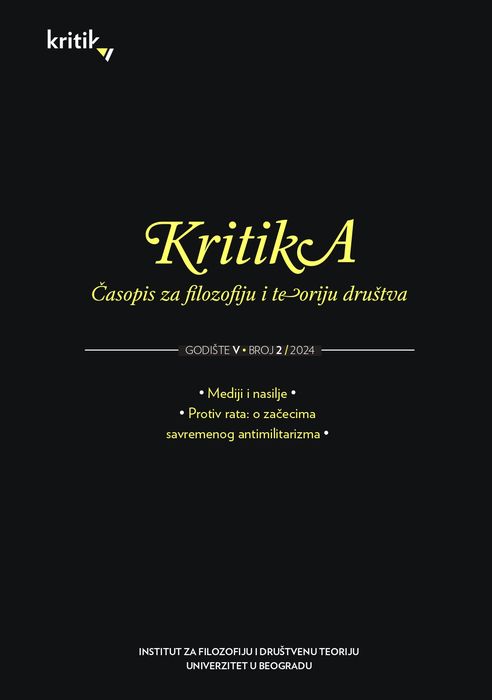ALTISEROVSKA PERSPEKTIVA: MEDIJSKI APARAT I NASILJE
ALTHUSSERIAN PERSPECTIVE: MEDIA APPARATUS AND VIOLENCE
Author(s): Srđan DamnjanovićSubject(s): Media studies, Theory of Communication
Published by: Institut za filozofiju i društvenu teoriju
Keywords: humanistic ideology; ahumanism; interpellation; interpellation by law; systemic violence; subjective violence; media; portals; Louis Altisser; Etienne Balibar
Summary/Abstract: Althusser’s “critique of the media” is based on two important theoretical topoi, i.e. ahumanism and interpellation. According to Althusser, the idea of man as a free, purposeful and creative individual is a mere ideological distortion, and therefore ahumanism is embodied in the belief that participants in the media landscape play certain predefined roles, like puppets in a street performance. The point in question is interpellation, addressing someone with “Hey, you, over there!”, producing subjects and intertwining ideological and oppressive functions of the media through the operation of the state ideological apparatus. Althusser analyses the function of the media, and consequently of violence, within the function of state ideological apparatuses. The media portrayal of violence and interpellation through violence represents a crucial aspect of Althusser’s theoretical intervention, with a paradigmatic event being the following one: a police officer addresses a suspect citizen and if they do not react in a proper way, the officer uses force according to the protocol or “somewhat too enthusiastically”. Apart from the “external gendarme”, it is necessary to activate another – probably more important – “internal” one. The citizens who follow the interpellation scene through the media are interpellated not only by the image on the web portal, but also by the explicit ideology formulated by the officials or those who criticize the scene. As stated above, our choice of the internet provider, cable operator or internet portal is not and cannot be the instance of our free will (likewise, the choice of a favourite radio station was not an example of free will in the past), but an instance of an ideological interpellation or self-interpellation. Another theoretical moment of great importance for our analysis is the assumption that state apparatuses function on the basis of material practices, and not through the distribution of wrong representations. Althusserian perspective can provide an answer to the question: What is the source of systemic violence? A social formation, in order to sustain itself, has to reproduce the conditions of its creation through the reproduction of the forces of production and production relations. The reproduction of workforce requires not only the reproduction of its skills, but also the reproduction of its submission to the rules of the established order. This reproduction of workers’ submission to the ruling ideology must be followed by the reproduction of the manipulation through the ruling ideology. Just as a worker must reproduce another worker, the capitalist must undergo the same process in order to perpetuate the order “through words”. Reproduction – quite simply and literally – means repetition. However, repetition is not a closed and self-sufficient process. Capitalism is renewed and expanded through the “heroic means” of political violence. In that way, violence is distributed through the “base and superstructure”, both horizontally and vertically, pulsating not only within Europe, but also within nation-states and in overseas countries, constantly expanding to new areas, encompassing a new circle of buyers and goods. Therefore, within developed metropolises, white spots, zones of low accumulation that need to be colonized again, are formed - such as urban cores, for example. In that process, state apparatuses, ideological and repressive, play a significant role, while the web portal serves as an ideological hub of the new media. It is a place of a simultaneous interpellation and self-interpellation. The information apparatus, in turn, participates in violence systemically, ensuring interpellation by promoting peace, solidarity, empathy and other “humanistic values”, while it can also endorse highly subjective messages that induce violence.
Journal: Kritika: časopis za filozofiju i teoriju društva
- Issue Year: 5/2024
- Issue No: 2
- Page Range: 309-329
- Page Count: 21
- Language: Serbian

